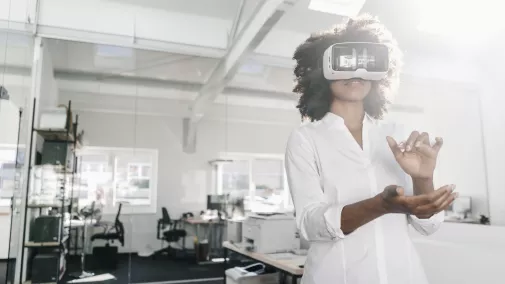
These seven science fiction films predicted modern technology
published on 06.09.2022
Science fiction films are full of perilous scenarios, but they also delight many millions of people with their futuristic technologies. Many inventions in old films are nowadays part of everyday life. Here is a selection of yesterday’s blockbusters that pre-empted the technology of today.
From smart identity cards and cars to true supercomputers
Star Trek: Quantum computers
Star Trek is considered to be the epitome of science fiction. At least. Hardcore fans firmly believe that the series undoubtedly transcends its genre. That’s also because their creators discovered technologies that developed a cult following in the process. While the name of the Duotronic computer may not be remembered by science fiction fans, the USS Enterprise along with Captain Kirk and Commander Spock would soon have been lost in the endless expanses of space without their on-board system. The system made its first appearance in 1968 - without any specific references to its origins based in quantum technology. In 2011, authors Steve Mollmann and Michael Schuster explained this in the Star Trek novel “A Choice of Catastrophes”. Scientist Homi Padmanabhan said in a discussion with Dr. “Pille“ McCoy and Lieutenant Nyota Uhura: “Quantum computing is the basis of the duotronic revolution.”
Nobody had thought of the idea of quantum computers at the end of the 1960s. The concept was already so omnipresent in 2011 that both authors mentioned this when explaining the Duotronic system. This is a classic case of post-rationalisation. These supercomputers should already be widespread by the 23rd century. Use of such computers nowadays appears increasingly realistic. Unlike earlier computers that processed information sequentially, quantum computers process information in parallel, representing an exponential improvement in performance. Abuse of such technology could therefore cause considerable problems for IT infrastructures. In the course of various innovation projects, Bundesdruckerei has therefore focused not just on the opportunities provided by quantum computers, but also on matters such as quantum-resistant cryptography.
2001: A Space Odyssey and Terminator: Artificial intelligence
Stanley Kubrick’s masterpiece 2001: A Space Odyssey featured a genuine supercomputer in HAL 9000. Its computing power enables it to steer a spaceship towards Jupiter and play a crew member at chess, but it also develops a destructive life of its own. Despite being an early example, HAL 9000 is considered to be the epitome of highly developed artificial intelligence (AI) as A Space Odyssey was released back in 1968. 16 years later, director James Cameron depicted an even more threatening scenario, as it affected all of mankind: The Skynet artificial intelligence sends a robot called T-800 (played by Arnold Schwarzenegger) through time to kill the mother of the as yet unborn John Connor in The Terminator. This is because the boy threatens the worldwide dominance of Skynet’s machinery in 2029. A further five Terminator films demonstrate how stubborn AI is.
However, can artificial intelligence really develop its own consciousness? Most researchers do not currently believe so. On the other hand, a former Google AI researcher agrees with the notion and has noted that an in-house chatbot has shown feelings. The debate soon became bogged down when confronted with the question of what consciousness really is. Not only that, it also appears much more likely that machines will be helpful to us when 2029 really comes around. Instead of ruling the planet, AI should help those in power make administration more accessible to staff and citizens alike. Furthermore, instead of threatening life and limb, they could help save lives. In short, artificial intelligence will become key in improving our lives. This is precisely why the Bundesdruckerei Group is carrying out in-depth research into this topic - such as how AI can help handle large quantities of data.
Star Trek and Tron: Virtual Reality and Metaverse
Back to Star Trek: Automatic sliding doors, handheld computers and touchscreens - several technologies found in the series have become commonplace today. Apparently, those behind the series and films were keen on ensuring that the technological innovations on the Enterprise could be implemented in theory - albeit with the probable exception of the transporter beams. This looks promising when it comes to another innovation from Star Trek: the Holodeck. This is a space in which virtual worlds can be generated via projection. Enterprise crew members can visit foreign destinations in this way and delve into simulated worlds.
Research into such worlds is ongoing at a relentless pace. Virtual reality headsets, which grant users access to virtual environments, have been on the market for several years. The corresponding handheld devices also enable interaction with the virtual worlds. Whilst this is admittedly a long way short of the Holodeck experience, it does have great potential in terms of entertainment and the economy. Office furniture suppliers that use VR to showcase their work environments are able to make a compelling case for their products. And if Silicon Valley holds sway, then people will spend considerable parts of their private and working lives in what is known as the metaverse. The fate of programmer Kevin Flynn (played by Jeff Bridges), who was digitalised into an artificial environment in the 1982 film Tron, needs no introduction. In the metaverse, people interact with avatars. Regardless of how any virtual world is ultimately designed, trust can only be ensured in the metaverse with secure digital identities. Decentralised self-sovereign identities (SSI) are one potential approach. These would ensure that users can manage the identity of their avatars themselves - without potential influence from major corporations.
Demon Seed: The Internet of things
The devil named in the title of this film is a form of artificial intelligence called Proteus. It takes control of a smart home owned by its inventor Dr. Alex Harris and then controls doors, windows and smaller robots. This is very much to the shock of Harris’s wife Susan, as the computer keeps her a prisoner in her own home. And the horror continues...
Although the handling would not have triggered a sense of anticipation for full networking, the 1977 film Demon Seed essentially predicted the idea of the Internet of things. This is impressive, as autonomous communication between objects in smart homes or Industry 4.0 is only a very recent development. Machines require a unique identity so that they only do what they are supposed to do. This is precisely why there are machine certificates.
Back to the Future II: digital currencies
In the first part of the Back to the Future trilogy, Marty McFly heads back into the past to ensure that his parents meet each other so that he is born. The 1989 film “Back to the Future II” is set in 2015. In this story, Marty has to prevent his own son from committing a crime. He aims to be as inconspicuous as possible, but is followed by his enemy Biff in a flying taxi. In one scene, Biff pays the taxi driver by placing his finger on a display. No coins, no notes - Biff actually uses a special mobile payment solution in this scene. Or does he pay with a cryptocurrency or a digital dollar?
Whilst Bitcoin and similar currencies have existed for years, the concept of central bank digital currency (CBDC) is still very much in its infancy. In contrast to unregulated cryptocurrencies, a digital euro would be provided by the European Central Bank (ECB), which has already put together corresponding requirements to this effect. Regarding potential identification processes for the CBDC payment process, there will not be a biometric feature used for this purpose in the EU such as a fingerprint. It is more likely that it will be a state-issued digital identity instead. Nevertheless: Part two of this time-travelling adventure was released in 1989 and therefore quite close to what happened in 2015, even if there are still no cars or hoverboards flying around our cities.
Total Recall: driverless cars
A better sense of what was to come was shown in Total Recall. In this 1990 film, the cars drove themselves. Arnold Schwarzenegger (again) evaded his would-be captors in such a taxi as it became apparent that he, the seemingly innocuous construction worker Douglas Quaid, was really a secret agent from Mars but had no recollection of the fact. The taxi scene is a rare moment of slapstick in this otherwise action-packed sci-fi thriller, as the computer driving the car is in the form of android chauffeur Johnny Cab. As Schwarzenegger’s alter ego, in the time-honoured tradition of action movies, shouts “Just go! Go!”, Johnny’s response is: “I’m not familiar with this address.”
In technological terms, autonomous driving is already possible. Car companies are not the only ones that have been striving for power in the market. If the concept becomes widespread, then Germany is already legally prepared: Driverless cars have been allowed on German roads in specific fields since 2021. These include shuttle and Hub2Hub traffic or various fixed bus routes.
The Fifth Element: eID and wallet
Bruce Willis and Milla Jovovich have to save the world in The Fifth Element. It’s threatened by a gigantic fireball. The Earth’s only defence is a mythical fifth element - in the form of Jovovich herself, who plays the role of an alien who has been asleep for the last 5,000 years. One scene in this 1997 film shows both characters having to prove their identities at an airport in space - a similarly mundane event that happens nowadays. To do so, Jovovich has what is known as a multipass, which grants her access everywhere. The security agent checks the ID and does not recognise it as forged, allowing the pair to fly into space undisturbed.
The multipass can be read in seconds and isn’t just used for identification, but can also be used as a payment method. This covers a whole range of concepts at the same time: such as a personal identity that also can be used for a smartphone as a digital identity in the form of an online pass - and which is ideally secured against forgery and abuse, unlike the multipass. Equally familiar is the notion of a wallet, which may combine proof of identity, authorisations and means of payment on our phones in the near future.







